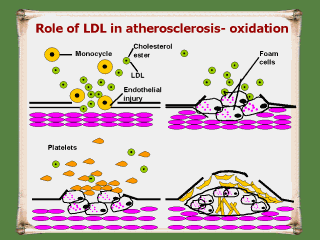| front |1 |2 |3 |4 |5 |6 |7 |8 |9 |10 |11 |12 |13 |14 |15 |16 |17 |18 |19 |20 |21 |22 |23 |24 |25 |26 |27 |28 |29 |30 |31 |32 |33 |34 |35 |36 |37 |38 |39 |40 |41 |42 |43 |44 |45 |46 |47 |48 |49 |50 |review |
 |
Oxidized
phospholipids derived from LDL that induce inflammatory response. In addition to being the major source of extra cellular cholesterol, LDL is also an important source of extra cellular phospholipids. some of the LDL phospholipids can yield oxidized phospholipids that induce an inflammatory response The oxidation hypothesis of atherogenesis has evolved to focus on specific proinflammatory oxidized phospholipids that result from the oxidation of LDL phospholipids containing arachidonic acid and that are recognized by the innate immune system in animals and humans. These oxidized phospholipids are largely generated by potent oxidants produced by the lipoxygenase and myeloperoxidase pathways. These oxidized phospholipids induce monocytes. It has been demonstrated that the inflammatory response elicited by the oxidized phospholipids, present in LDL is mediated in part by induction in smooth muscle cells and endothelial cells of monocyte chemo attractant protein (MCP)-1, interleukin-8 and macrophage colony stimulating factor. From the work of many laboratories, the concept has emerged that LDL must be ‘primed’ for oxidation. Studies on a subpopulation of freshly isolated LDL that was enriched in lipid hydroperoxides, which they termed ‘LDL negative’ (LDL -) showed LDL oxidation by metal ions in vitro, and on the basis of their observations they concluded that LDL must be ‘seeded’ with reactive oxygen species before it can be oxidized. (Navab M et al. The oxidation hypothesis of atherogenesis: the role of oxidized phospholipids and HDL J Lipid Res. 2004 Jun;45(6):993-1007. Epub 2004 Apr 01) |